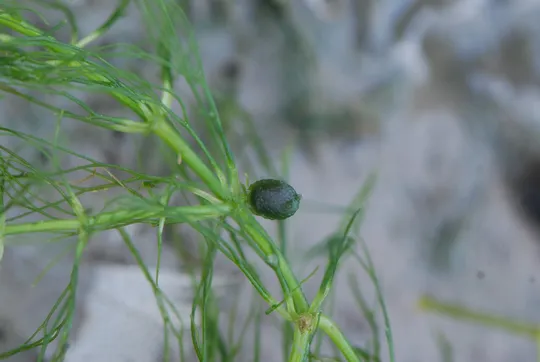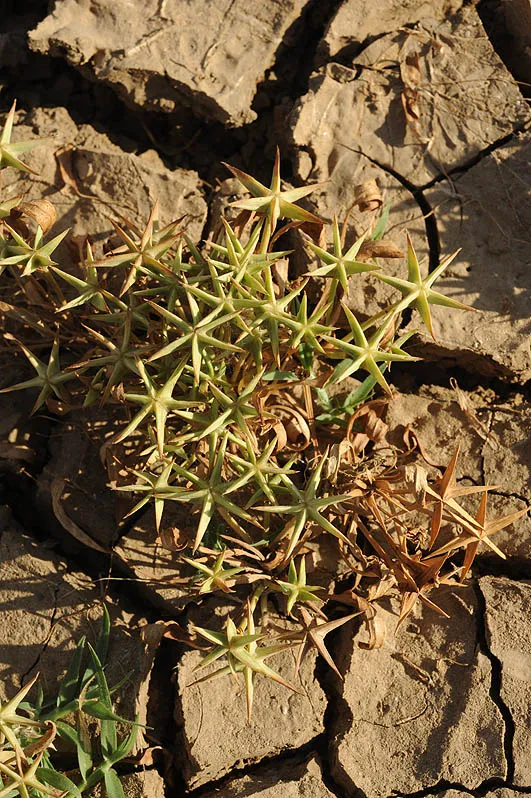Soft Hornwort, Spineless Hornwort
Ceratophyllum submersum

Ceratophyllum submersum plants serve as
shelters for various organisms (fish, snails, etc.) and the leaves, fruits and
seeds are used for food by birds and fish. Numerous epiphytes, particularly diatoms,
filiform algae and miniscule organisms are found on the plant. The plant is
used in aquariums.
Ceratophyllum submersum is currently found with
certainty only in the Hula Valley
and in the Jezreel Valley, at a total of five sites, of which four
are in the Hula Valley – the Hula Nature Reserve and
Agamon HaHula (Talia Oron), Te'o
springs (Ǧahula) and Wadi Barad. In the Jezreel
Valley it was found by Rachel
Einav for the first time near Yokne’am
in 2009. C. submersum is very
similar to C. demersum,
which makes its identification difficult and other observations are doubtful. There
are an estimated ten sites in the country.
Springs and ponds.
The genus
Ceratophyllum is the only one in the Ceratophyllaceae family and
includes three species (some
researchers believe that the number of species
reaches 30). Two of them, C. demersum and C. submersum grow in Israel. C. demersum
is more common in Israel than C.
submersum, but most
of its populations are at risk due
to the great vulnerability of wetland
habitats to desiccation and
pollution.
Ceratophyllum submersum is known from a few sites in northern
Israel, from some of which it is now extinct. Although
there have been new discoveries in
recent years, there is no certainty regarding
the stability of populations. All the water
bodies in Israel are threatened. It is
not globally endangered.
New surveys should
be conducted in water reservoirs in
northern Israel to locate additional populations. The biology
and ecology of the species in its
natural habitat should be studied in order
to formulate recommendations for conservation and to prepare
a management program. The taxonomy of Ceratophyllum
species in Israel should be studied to find identifying signs which can
be used to identify the species in
the field. This will allow the species distribution to be remapped and
population sizes to be estimated.
Ceratophyllum submersum is
broadly distributed in temperate continental Europe. It also grows in most European
and North African Mediterranean
countries – Spain, France, Italy, former
Yugoslavia, Greece, Turkey, Bulgaria, Syria and Lebanon, Morocco, Algeria, Tunisia and Libya. It is known from some tropical African
countries – Ghana, Congo, Kenya and Tanzania as well. There are also a few reports from
Siberia and tropical America.
Ceratophyllum submersum is a rare submerged
aquatic perennial plant that grows in a small
number of wetlands in northern
Israel. Its habitat is vulnerable and little
is known about its ecology and the
degree of perseverance of its populations in
its known sites.
ויזל, י. וליפשיץ, נ. 1979. צמחי מים בישראל.הוצאת רשות שמורות הטבע.
Current Occupancy Map
| 1000 squre meter pixel | 5000 squre meter pixel | 10000 squre meter pixel | |
|---|---|---|---|
| number of observations | 0 | 0 | 0 |
| in total pixels | 0 | 0 | 0 |
| Family | Ceratophyllaceae |
| Classification | On the endangered species list |
| Ecosystem | Mediterranean humid |
| Chorotype | Euro-Siberian – Mediterranean - Irano-Turanian |
| Conservation Site | Agamon HaHula, Hula Nature Reserve |
| Rarity |
1
3
6
|
|---|---|
| Vulnerability |
0
3
4
|
| Attractiveness |
0
0
4
|
| Endemism |
0
0
4
|
| Red number |
1
3.2
10
|
| Peripherality | 0 |
| IUCN category | DD EW EX LC CR EN VU NT |
| Threat Definition according to the red book | Vulnerable |
 Based on:
Based on:






